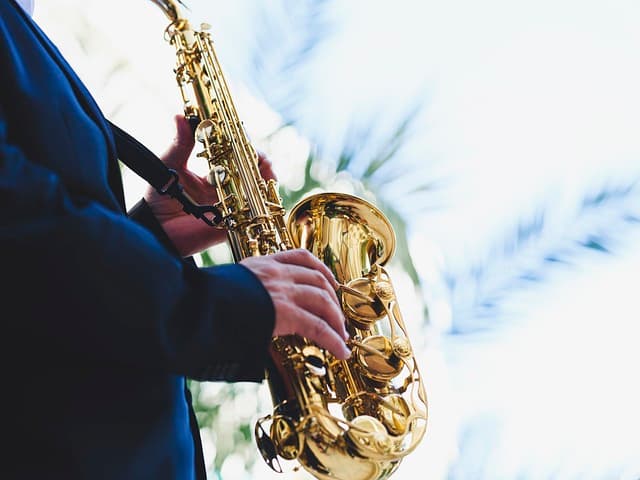This article is dedicated to all those who want to invite a band to play live sound, but do not know enough about it. First, general information about musical instruments.
There are two kinds of musical instruments:
- Acoustic
- Electric
Acoustic instruments include:
- Various percussion instruments (drums, percussion, etc.)
- wind instruments (trumpets, saxophones, pipes, etc.)
- strings (acoustic guitars, contrabasses, balalaikas)
- keyboards (grand pianos, pianos, organs)
You do not have to strain your ears to hear acoustic musical instruments at normal volume.
To the electromusical instruments are the same instruments, only performed in the electric version and working on electricity. We will talk about them in more detail, as they are used by modern musical ensembles and bands.
How the sound of musical instruments is formed
Many people make the mistake of thinking that an electric guitar, bass guitar or a synthesizer are plugged in and sound. But it’s not as simple as that.
To hear the sound you need sound amplification equipment. Electronic musical instruments sound very soft by themselves (electric guitar, electronic drums, bass guitar), or they don’t sound at all (keyboards).
To sound electric and bass guitars you need a “cabinet” (speakers) and a “head” (amplifier), or a combo box (“head” and “cabinet” connected together).
Sounding the keys requires a line input in the mixing console (a mixer is an electronic device designed to summarize the sound signals of several sources into one or more outputs) to which the signal is sent.
Electronic drums have a similar connection principle as keys. The sound of each drum is sent to an electronic module, from which it already goes to the input of the mixer.
Acoustic drums are the most difficult to set up and most commonly used. For each drum (bass drum, snare drum, alto, tom, floor tom) a microphone is installed, the sound from these microphones goes into the mixer. But that’s not all, there are also cymbals. “Hat” (two cymbals mounted on the same bar and controlled by a pedal) and “Ride” (a cymbal with a ringing, hissing sound) are mic’d up, then two mics are mounted on the right and left over the drums, which are called “overheads.” They capture the overall sound of the cymbals and create a stereo sound. All cymbal mics are also fed to the mixer.
Vocal microphones either directly or through processing (reverb effects, sound compression, etc.) are connected to the mixing console. If there are wind or other acoustic instruments in the band, the microphones also pick up the sound from them, as well as from the drums.
Then the sound from the mixer goes to the power amplifier of sound frequencies, then the signal is transmitted to the acoustic system from which the listener in front of the stage hears the sound.
Sound on Stage. Soundcheck .
But that’s not enough. At the banquet, the musicians also need to hear themselves on stage. If the sound is bad and unreadable and the musician can’t hear himself or his partner, he can lose rhythm, go out of tune, play the wrong notes or break his voice altogether. The performance will turn into a nightmare for performers and listeners alike.
In order for the musicians to hear themselves, speakers are placed on stage, aimed at the group. Most often they are floor monitors (special acoustic systems for sounding the stage), sometimes they use speakers (ordinary not very powerful acoustic systems standing on the sides, directed to the stage).
Before the performance, musicians have to tune instruments and sound – this event is called sound check. It can last from 30 minutes to 3-4 hours.
The first to be set up is the drum kit. The drums should be set up so that their sound makes you “rock”:)
After the drums tuning starts with the bass guitar. They try to make it sound smooth and dense, so together with the drums they were one unit
Then they tune up the guitar. It has to be readable, the spectator should hear a bright even sound, but at the same time the guitar shouldn’t be too loud.
Keyboards are set up smooth pleasant and balanced sound to create the volumetric sound and fullness of the musical space
Vocals are paid much attention, because 80% of the success of the band depends on it. The microphone is adjusted depending on the type of vocals: male or female. Try to get rid of stray frequencies and noise (everyone has ever heard whistling at concerts, they are). The voice must be readable, it is necessary that each word of the vocalist tries to reach the listener.
Ultimately, tuning comes down to creating a musical picture as a whole. The listener should not be irritated by anything or vice versa.
But even if the musicians are professional, they can sound like a street band because of poor quality equipment, not held sound check, the lack of a sound engineer.
It is also necessary that the speakers did not disturb, not irritated, and were only positive emotions and good humor, then the concert, no matter what will pass all 100%. And the audience and the musician will be satisfied with the performance and will remember it for a long time!
